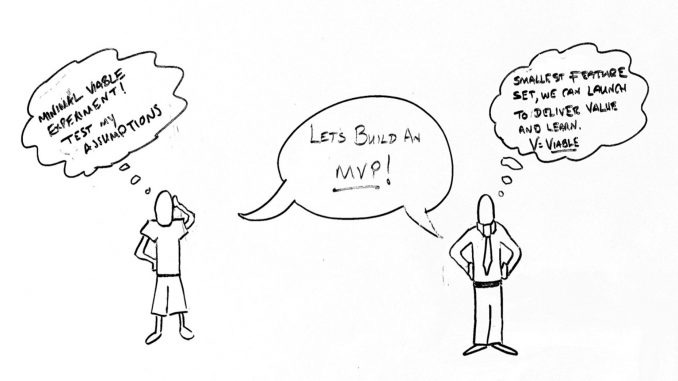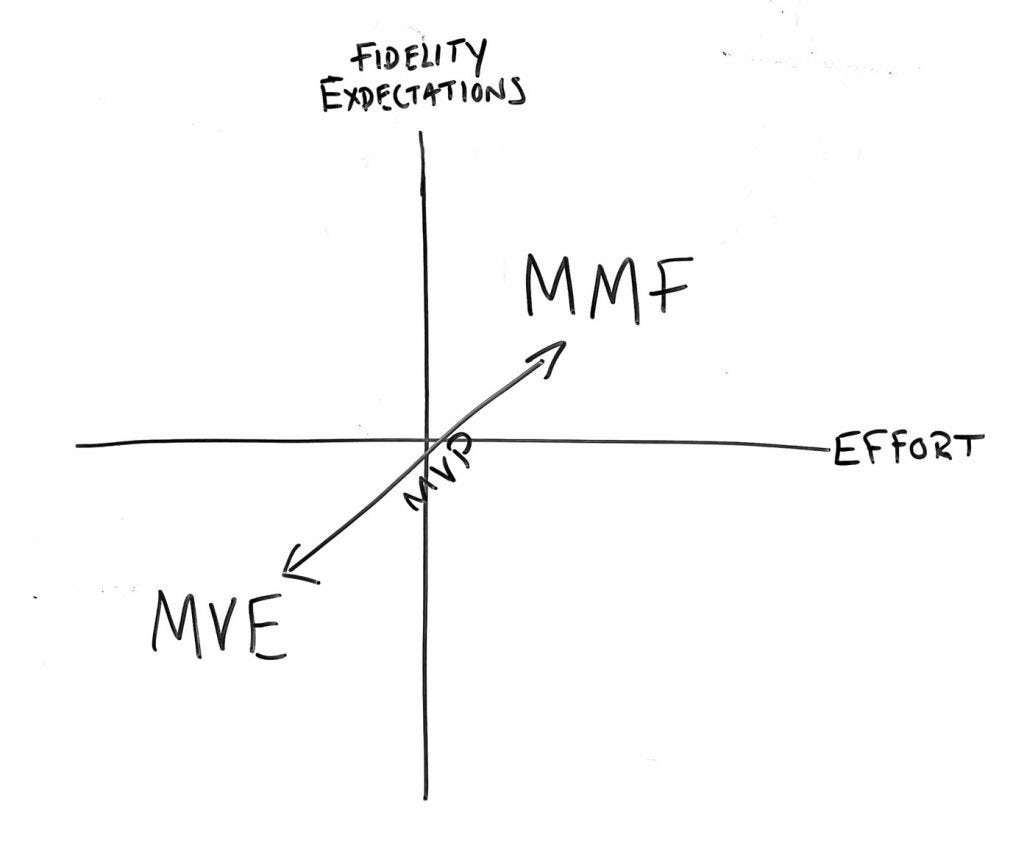On a regular basis I’m challenged with the misalignment and understanding of what a Minimum Viable Product (MVP) means to different people. Through my engagements with peers, partners and customers It seems I’m not alone in this. It can be very expensive and frustrating when expectations are not aligned with what seems a very simple and obvious term of MVP. Due to the observed frequency of this disparity, I’ve decided to stop or at least minimise my use of MVP in favour of alternative more clarifying terms.
What Does An MVP Commonly Mean For An Early Stage Idea ?
If you’re a startup, nurturing a new business idea, experimenting with a new feature or trying to learn about a risky assumption, then delivering an MVP is all about minimising effort to learn. MVP is a process not an output. You want to identify clearly what you are trying to learn, support it up with clear experimental hypotheses and success criteria and spend the Minimum amount of time and effort to do so. This means you’re not thinking about scaling, you’re not thinking about all the related subsequent features and you’re definitely not spending months delivering this. Use what you can off the shelf and favour speed over scalability.
“First, a definition: the minimum viable product is that version of a new product which allows a team to collect the maximum amount of validated learning about customers with the least effort.” https://leanstartup.co/what-is-an-mvp/
What Does An MVP Commonly Mean In An Enterprise ?
Enterprises are trained to think differently. The governance and culture in place doesn’t lend itself well to experimentation, but it’s all about risk, reputation and scalability. So when modern digital ways of working and product management practices encourage experimentation, to learn as specified in the previous definition, it is not initially compatible and understood with the culture and mechanisms in place. It is absolutely possible to overcome this (The Lean Product Lifecycle being one such example), but tension will emerge when expectations are not aligned.
What I have commonly observed in this context is that MVP in enterprise becomes more output focused and is actually an alternative term for Minimum Marketable Features (MMF). This is the minimum feature set that you can launch as part of the planned product or feature :
“A minimum marketable feature (MMF) is the smallest set of functionality in a product that must be provided for a customer to recognize any value. In this context, a feature is something within the product that is individually perceived as having value by the user.” https://whatis.techtarget.com/definition/minimum-marketable-feature-MMF
Ok Well What About Using Minimum Lovable Product (MLP) ?
This doesn’t fix the problem. Although I really like the idea and intention, just like the term “Viable”, “Lovable” is subjective and open for interpretation. In Amazon we recognise terms like this at “Weasel Words”, as there is a vagueness to them which can lead to confusion and misinterpretation. When I see MLP applied, there is an expectation that the customer satisfaction has to be high from the start. Don’t get me wrong, this is a goal I aim for and promote in all products and features, but stating that when you’re trying to learn and experiment with a definition of MVP can sometimes introduce waste.
A Minimum Lovable Product (MLP) is an initial offering that users love from the start. It represents the minimum that is required for customers to adore a product, rather than merely tolerating it. https://www.aha.io/roadmapping/guide/plans/what-is-a-minimum-lovable-product
When it comes to MMF though, replacing this to MLP or Minimum Lovable Features (MMF), can have a positive effect and counteract and combat the temptation to aim low on customer satisfaction to satisfy the delivery focus of time and requirements. Where I see people not focusing enough on the customer, I introduce ‘Lovable’ to remind them who this product or feature is for.
Aligning On Terminology
Whatever your stance on these definitions, one thing for sure is that you need to be clearly aligned across your teams, business and relationships with stakeholders on what you mean. Doing so will reduce potential friction, frustration and waste for your teams and create more alignment.
I always seek to re-specify terms when engaging with new people and in smaller teams this is less of a problem. However when your company network increases in size, you can’t control the definition and interpretation. This is where being more specific can help to reduce the chances of expectation misalignment.
I’ve shared below a simple way of how I attempt to replace my use of the term MVP, when I see this becoming an issue.
The above is my personal perspective and approach, which I’m sharing as it helps me overcome a problem I observe. If you have any questions or have used an alternative or similar approach when seeing the challenges of MVP’s, please feel free to comment below or contact me directly.





Cheers, Craig. This has been a problem of mine for some time, while trying to help the organization work more customer-centric. Management wants MVP’s that can be sold. I will start waving your framework around. 🙏🏻😃
Thanks Anders, glad you found it useful.